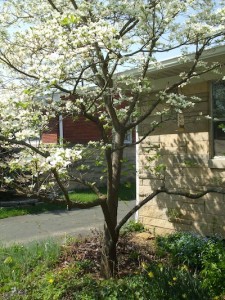
- Native dogwood colors the view from the inside out. (C) Jo Ellen Meyers Sharp
Several of my BFF on Facebook have been commenting on the gorgeous fall colors this year.
The reds, yellows, golds and bronzes have been slow coming despite an ideal October. The rains late in the month seemed to have hastened and intensified the season.
The conversation on Facebook soon shifted to which season has the most color: spring or fall?
Certainly, fall colors are intensely saturated. They cover the view, from the fallen leaves on the ground to colored foliage on trees and shrubs made all the more striking by an incredible blue sky. In spring, the pastel and primary colors of bulbs and early emerging perennials punctuate the verdant shades of greens. Maybe because I was born in fall, I find the colors of the season comforting. Spring colors are uplifting.

Native dogwood in spring. (C) Jo Ellen Meyers Sharp
For whatever reason, some of the plants in my landscape have not received their fall-color orders.
The green leaves on ‘Sike’s Dwarf’ and ‘Pee Wee’ oakleaf hydrangeas (H. quercifolia) have not turned their wine red color of fall and winter. The foliage on Summer Wine ninebark (Physocarpus opulifolius ‘Seward’) is as purple as ever without a touch of fall’s fire red.
The ‘Princeton Sentry’ ginkgo (G. biloba) leaves remain green. When they turn gold, the distinctive fan-shaped leaves, practically all at once.
What does have color? The spireas, including Snow Storm (Spiraea x media). This 3 foot tall and wide shrub has beautiful blue leaves in summer, large lacecap white flowers in early spring and fiery red-gold leaves in fall.
Similar in size is Glow Girl spirea (Spiraea ‘Tor Gold’), which also has white flowers, but lemon-lime foliage in summer, which turns golden red in fall. I think gardeners frequently overlook spireas as a source of late season color.
The intense, red leaves of the native dogwoods (Cornus florida) are spectacular inside and outside my picture window. Their fall color and spring flowers reinforce why we sometimes plant for the inside to outside view, whatever the season.